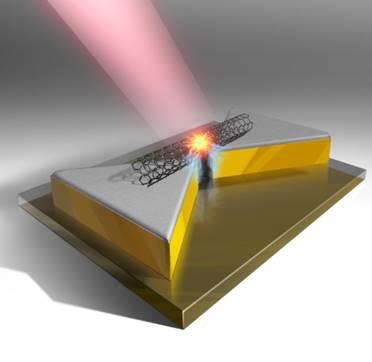(Nano-transistors) Tube (nanoelectronics) (less than 01 nm)
Researcher and author: Dr. ( Afshin Rashid)
Note: In the production, propagation and promotion of nanotransistors, the fabrication of nanotubes is very important. For the fabrication of nanotubes, the most important difference is between the methods based on gas and solid source. CCVD typically uses low temperatures, and nanotubes grow below 0111 ° C.
More than one mechanism can be involved in the growth of carbon nanotubes depending on the type of gaseous precursor, the catalyst used and the operating parameters . The dissolution-diffusion-deposition mechanism is one of the most common, which is more prevalent in low temperature methods. In this mechanism, catalytic nanoparticles of metal alloys or intermediates (such as nickel, iron, and cobalt) are considered spherical or floating on the substrate surface . Hydrocarbon vapors (such as CO, CH4, C2H2, C2H4, and C2H6). When it comes in contact with hot particles, the catalyst decomposes into carbon and hydrogen, and carbon seeps into the substrate metal . With a weak substrate, the metal should have an acute contact angle with the substrate (nanotube at the bottom of the catalyst) (tip growth) and if the catalyst interacts with the substrate is strong, the metal has an open contact angle with the substrate, the nanotube grows on top of the catalyst (growth base). In the first case, it is possible to produce nanotubes with an open end. The physical shape of the deposited carbon of single-walled, multi-walled, amorphous, and graphite-layered carbon nanotubes covering catalytic nanoparticles depends on many factors, such as the size of the catalytic particles and the rate of deposition. When the deposition rate is equal to or less than the carbon penetration rate, a graphite layer forms around the catalytic nanoparticles. When the deposition rate is higher than the carbon penetration rate, carbon nanotubes are formed. The size of catalytic nanoparticles plays an important role in the growth of nanotubes, generally catalytic nanoparticles with small size (less than 01 nm) for nucleation and The growth of carbon nanotubes are active. If the particle size is about one nanometer, a single-walled nanotube is formed. Catalytic nanoparticles with a size of 01 to 51 nm lead to the growth of multi-walled nanotubes. Catalytic nanoparticles larger than 51 nm are also coated with amorphous graphite sheets.
Graphene has a wide range of applications in the field of electronics due to some unique physical properties. Among these properties, the mobility of charged particles in graphene or the mobility represented by the letter μ is very important. The mobility value for graphene sV / cm2 is 100,000, and the saturation rate for it is reported to be about 10 × 107 s / m. The combination of these properties makes graphene a powerful conductor for electronic applications, including those used in transistors. In the production and propagation of tubular nanotransistors, carbon nanotube production methods are divided into two general categories of methods based on solid carbon and gas source. CCVD methods generally use lower temperatures to produce carbon nanotubes than a solid carbon source. Understanding the mechanism of nanotube production Carbon dioxide is a very important approach in the production of nanotransistors in order to optimize its properties. Many parameters such as crystal particle size, substrate type and sedimentation rate are involved in these mechanisms. Catalyst size is one of the important and influential factors on the characteristics of carbon nanotubes produced and by changing it, multi-walled and single-walled carbon nanotubes can be produced. Some methods, such as arcs and molds, are capable of producing carbon nanotubes in the absence of catalysts, resulting in higher purity products.
Conclusion :
In the production, propagation and upgrade of nanotransistors, the fabrication of nanotubes is very important. For the fabrication of nanotubes, the most important difference is between gas and solid source methods. CCVD typically uses low temperatures, and nanotubes grow below 0111 ° C.
Researcher and author: Dr. ( Afshin Rashid)
PhD in Nano-Microelectronics




